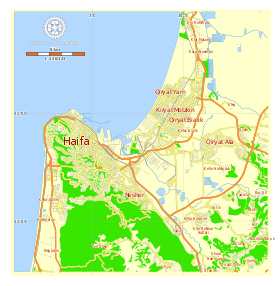Usuario:Cansado/Taller/Krayot
| Krayot הקריות | ||
|---|---|---|
 Vista aérea de las Krayot: Kiryat Bialik, Kiryat Motzkin, Kiryat Yam y parte de Kiryat Haim; En la parte superior (norte) de la imagen se puede ver el Golfo de Akko; noviembre de 2014.
| ||
 | ||
| • País | Israel | |
| • Distrito | Haifa | |
| Superficie | ||
| • Total | 63.66 km² | |
| Altitud | ||
| • Media | 15 m s. n. m. | |
| Población (2020) | Puesto 3.º | |
| • Total | 221 698 hab. | |
| • Densidad | 4186,30 hab./km² | |
Las Krayot (hebreo: הקריות, "municipios") (plural de Kirya) es una aglomeración urbana de cuatro pequeñas ciudades y dos barrios de Haifa fundados en la década de 1930 en las afueras de la ciudad de Haifa, Israel, en el área de la Bahía de Haifa.[1][2][3][4]
De norte a sur, las ciudades que la conforman son:
- Kiryat Yam (39.458 habitantes)[5]
- Kiryat Bialik (41.913 habitantes)[6]
- Kiryat Motzkin (45.463 habitantes)[7]
- Kiryat Ata (59.364 habitantes)[8]
- Kiryat Haim (32.600 habitantes)[9]
- Kiryat Shmuel (5.500 habitantes)
Una parte significativa de la población llegó a las Krayot después de 1990 durante la gran aliá de la Unión Soviética. El número de inmigrantes a las Krayot (excluyendo Kiryat Haim) a finales de 2004 fue de 41.500.
En varias ocasiones hubo propuestas para fusionar estas ciudades en un solo municipio,[10] especialmente en 2003 e impulsado por el Ministro del Interior Aryeh Deri, y nuevamente en 2016. Un nombre propuesto para esta ciudad fue Ir Zvulun o Ir ha-Krayot, con una población de aproximadamente 250.000 personas, lo que la convertiría en una de las diez ciudades más grandes de Israel.
Referencias
editar- ↑ Words and Stones : The Politics of Language and Identity in ... Daniel Lefkowitz Assistant Professor of Anthropology and Asian & Middle Eastern Languages & Cultures University of Virginia - 2004 Page 58 "Far below lies Checkpost, a shopping, entertainment, and transportation hub, and the gateway to the eastern suburbs called the Krayot." Most Neve Yosef residents have friends or relatives who live in the Krayot...."
- ↑ Munio Gitai Weinraub: Bauhaus architect in Eretz Israel - Page 53 Richard Ingersoll - 1994 "(Jewish Agency Archives) Weinraub's most extensive involvement with the labor movement occurred in the workers' suburbs, or krayot, to the west of Haifa."
- ↑ Our Hearts Invented a Place: Can Kibbutzim Survive in Today's Israel? - Page 173 Jo-Ann Mort, Gary Brenner - 2003 "Most of the new tenants are coming from Nahariya, Akko, and the Krayot [suburbs of Haifa]."
- ↑ Civilians under assault: Hezbollah's rocket attacks on Israel in ... - Page 73 2007 "HaKrayot, Hebrew for the towns, refers to the coastal suburbs between the city of Haifa to the southwest and Akko to the north. HaKrayot's population is about 300,000, exceeding that of Haifa. It includes both vast industrial zones as well as...."
- ↑ «קריית ים» [Kiryat Yam]. Oficina Central de Estadísticas de Israel (en he-IL). 2020. Consultado el 6 de julio de 2022.
|sitioweb=y|work=redundantes (ayuda) - ↑ «קריית ביאליק» [Kiryat Bialik]. Oficina Central de Estadísticas de Israel (en he-IL). 2020. Consultado el 6 de julio de 2022.
|sitioweb=y|work=redundantes (ayuda) - ↑ «קריית מוצקין» [Kiryat Motzkin]. Oficina Central de Estadísticas de Israel (en he-IL). 2020. Consultado el 6 de julio de 2022.
|sitioweb=y|work=redundantes (ayuda) - ↑ «קריית אתא» [Kiryat Ata]. Oficina Central de Estadísticas de Israel (en he-IL). 2020. Consultado el 6 de julio de 2022.
|sitioweb=y|work=redundantes (ayuda) - ↑ «רובע קריית שמואל - קריית חיים» [Barrios Kiryat Haim - Kiryat Shmuel] (PDF) (en יקנרקם). 2008. p. 34.
- ↑ Petersburg, Ofer (18 de diciembre de 2016). «התוכנית של דרעי: לאחד את הקריות לעיר אחת» [El plan de Deri: Unificar las Krayot en una sola ciudad]. Yedioth Ahronoth (en hebreo). Consultado el 5 de julio de 2022.